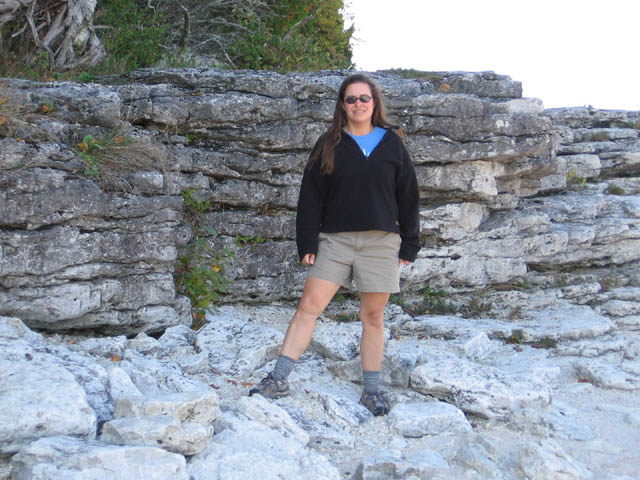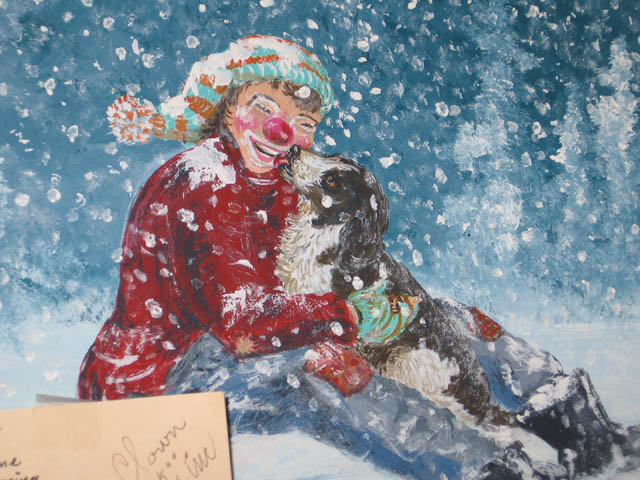Letters from a Writer: Don’t Laugh, Clown, Don’t Laugh
Jean Sramek reports on her fall vacation. The leaves may or may not have been in evidence; what she found thick on the ground was GIFTS. And clowns.



I recently spent nine days vacationing in Door County, Wisconsin. If you want the Chamber of Commerce version of how nice Door County is, by all means Google it. If you want the real version of how nice Door County is, read on.
Door County is basically an enormous gift shop with paved roads and a sewer system. It is picturesque, has hundreds of miles of wild Lake Michigan shoreline (only a fraction of which—so far—has been polluted by condominium developments), is great for backroads bicycling, and they grow fruit there—which they sell, along with gifts. Signs hung in windows and on roadsides and on sidewalk kiosks proclaim: Dried cherries AND GIFTS. Espresso AND GIFTS. Women’s designer clothing AND GIFTS. Fishing charters, bait, licenses AND GIFTS. Bistro AND GIFTS. Rolfing AND GIFTS. Pick-your-own apples AND GIFTS. Chiropractor AND GIFTS. Auto repair AND GIFTS. It made me want to write a really bad novel, which would later be turned into a pretty good movie, called The Gift Shops of Door County—but honestly, how many times can a thing be parodied? Meryl Streep is too tall to play me, anyway.
The subject of why humans need to buy each other so many gifts could fill twenty or thirty future columns and so will be tabled for now. Suffice it to say that, if you can manage to avoid the gift shops of Door County, and if you don’t mind the “we don’t care because we don’t have to” customer service that proliferates in remote locations such as islands or peninsulas, Door County is a soul-quenching, beautiful place to explore. If you enjoy being smugly ironic and making fun of gift shops and you enjoy gorgeous Lake Michigan shoreline, so much the better.
My spouse and I were mid-vacation, driving now instead of bicycling, and saw a sign: Lakeview Gifts. Hummels, Collector Plates. Clown Paintings. Gifts & Figurines. Ha-ha, more gifts. Gifts gifts gifts gifts AND GIFTS. Ha-ha, ha-ha, smugly ironic ha-ha, followed by a few thousand feet of silent driving. Hold on a minute, we said. This was no ordinary gift shop. It was the mother lode. It had clown paintings. John pulled off the highway at the earliest possible opportunity and we drove back north to the small yellow building that housed Lakeview Gifts.
It had no view of the lake, just a view of State Highway 57. The house, we soon learned, was a model home—a double-wide, where the proprietor had raised four children, worked as a clown, and opened a gift shop. In that order. We rang the bell smugly and ironically and then knocked when no one answered. Finally, a woman in her late 70’s answered the door and sweetly apologized for the delay. She’d been in the back, doing something. We stepped into a cramped room that had once been the model home’s living room but was now filled with, well, gifts. With clown paintings.
Clown paintings are different than other clown-flavored collectibles. There are clown figurines, clown dolls with ceramic heads and feet, soft stuffed clowns, and clowns that dangle from strings; these clown things are cute and shallow. Clown paintings, on the other hand, depict adult men (only men, for some reason), dressed shabbily in the style of a hobo, in various poses and situations. For instance: a man wearing a suit, complete with hat and tie, shredded from use; he is leaned up against a railroad car or fence; he is wearing a red nose and clown makeup on his face; his expression is sad or pensive. That theme is repeated in these clown paintings. If these clowns were to appear in real life, we would say they were homeless people with access to a stage makeup kit. But the clowns in the clown paintings do not look mentally ill or have the demeanor we associate with the homeless. Instead, they look resigned, independent, almost rugged. They look like they have answered a divine calling to be clowns and to wear the same tweed suit until it has big holes in it. They’re circus monks.
In the model home turned Lakeview Gifts, I spotted a clown painting triptych. One of the scenes was a square-jawed, handsome clown, his masculine hand shielding his red-nosed face from the setting sun. Like if Clint Eastwood starred in The Clown Paintings of Door County. The set of three paintings was marked down to $1,243.00 plus Wisconsin sales tax and I briefly considered buying it, even though that would have doubled the budget for our entire trip. I also considered a ploy to get the little old lady out of the room so I could quietly photograph these horrible yet highly collectible items. But by then she was talking to John.
“Do you collect clowns?” she beamed. “Sure,” John answered cheerfully, and with that, our smugly ironic selves skulked away and waited outside in the car, because the woman started talking about Red Skelton, and what human being—especially smugly ironic human beings who were kids in the 60’s—doesn’t have a soft spot for Red Skelton and TVs without remotes and the days before laughing at a hobo wasn’t politically correct? The woman and her late husband had worked as volunteer clowns (“Buddy and Bubbles”) for some organization that fulfilled the wishes of terminally ill children. They had met Red Skelton several times. Here were pictures of Buddy, Bubbles, and Red. They had been to Florida. Here were pictures of Buddy and Bubbles with Santa Claus and a kid with cystic fibrosis at Sea World. This went on for years. Eventually, “Bubbles” had so much clown stuff around the house that “Buddy” suggested she open a gift shop.
Our smugly ironic selves were now thumbing a ride back to Duluth, hanging their heads in shame. This gift shop was the real deal AND GIFTS. John bought a stuffed clown named Chuckles with a glazed ceramic head and white gloves. I bought a T-shirt printed with the slogan I LOVE SHRINER CLOWNS. “Bubbles” pressed our purchases into our hands and apologized for talking so much and taking up so much of our time and telling us her life story.
It was probably the first, and most, ironic thing she had ever said.